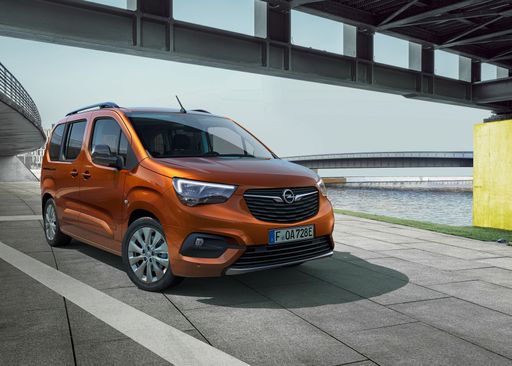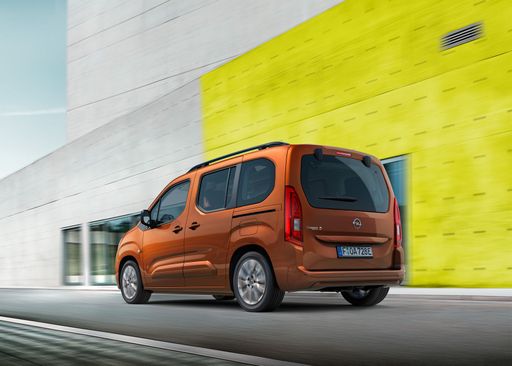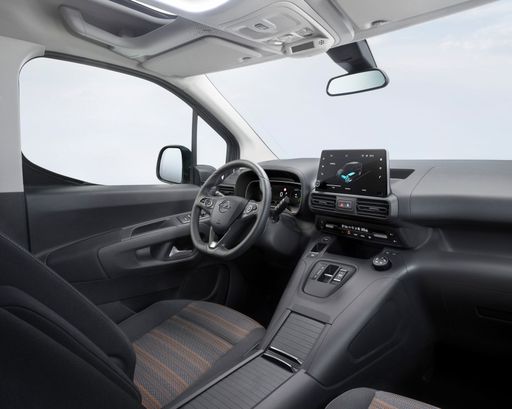Vauxhall Combo vs Renault Trafic Bus – Differences & prices compared
Compare performance, boot space, consumption and price in one view.
Find out now: which car is the better choice for you – Vauxhall Combo or Renault Trafic Bus?
The Vauxhall Combo (High Roof Estate) comes with a Electric or Diesel engine and Automatic or Manuel transmission. In comparison, the Renault Trafic Bus (Bus) features a Diesel engine with Manuel transmission.
When it comes to boot capacity, the Vauxhall Combo offers 850 L, while the Renault Trafic Bus provides – depending on how much space you need. If you’re looking for more power, decide whether the 136 HP of the Vauxhall Combo or the 150 HP of the Renault Trafic Bus suits your needs better.
In terms of consumption, the values are 18.50 kWh5.50 L per 100 km for the Vauxhall Combo, and 6.80 L for the Renault Trafic Bus.
Price-wise, the Vauxhall Combo starts at 24000 £, while the Renault Trafic Bus is available from 38200 £. Compare all the details and find out which model fits your lifestyle best!
Vauxhall Combo
The Opel Combo high-roof estate car stands out for its impressive versatility, making it an ideal choice for both families and professionals. Its spacious interior and clever storage solutions ensure a comfortable ride and plenty of room for all your needs. With a focus on practicality and efficient design, the Combo seamlessly combines functionality with modern driving technology.
details @ media.stellantis.com
@ media.stellantis.com
 @ media.stellantis.com
@ media.stellantis.com
 @ media.stellantis.com
@ media.stellantis.com
 @ media.stellantis.com
@ media.stellantis.com
Renault Trafic Bus
The Renault Trafic Bus is a versatile and spacious option for those needing to transport multiple passengers comfortably. With its modern design and practical features, it is well-suited for both business and leisure purposes. Its efficient engine and smooth handling make it a reliable choice for long journeys.
details

|
|
|
|
|
Costs and Consumption |
|
|---|---|
|
Price
24000 - 36500 £
|
Price
38200 - 51100 £
|
|
Consumption L/100km
5.5 - 5.9 L
|
Consumption L/100km
6.8 - 7.2 L
|
|
Consumption kWh/100km
18.5 - 18.8 kWh
|
Consumption kWh/100km
-
|
|
Electric Range
333 - 345 km
|
Electric Range
-
|
|
Battery Capacity
-
|
Battery Capacity
-
|
|
co2
0 - 155 g/km
|
co2
179 - 188 g/km
|
|
Fuel tank capacity
53 L
|
Fuel tank capacity
80 L
|
Dimensions and Body |
|
|---|---|
|
Body Type
High Roof Estate
|
Body Type
Bus
|
|
Seats
5 - 7
|
Seats
8 - 9
|
|
Doors
4 - 5
|
Doors
4
|
|
Curb weight
1530 - 1922 kg
|
Curb weight
2031 - 2321 kg
|
|
Trunk capacity
597 - 850 L
|
Trunk capacity
-
|
|
Length
4410 - 4760 mm
|
Length
5080 - 5480 mm
|
|
Width
1848 mm
|
Width
1956 mm
|
|
Height
1812 - 1818 mm
|
Height
1973 - 1974 mm
|
|
Payload
430 - 840 kg
|
Payload
749 - 982 kg
|
Engine and Performance |
|
|---|---|
|
Engine Type
Electric, Diesel
|
Engine Type
Diesel
|
|
Transmission
Automatic, Manuel
|
Transmission
Manuel
|
|
Transmission Detail
Schaltgetriebe, Automatikgetriebe
|
Transmission Detail
Schaltgetriebe
|
|
Drive Type
Front-Wheel Drive
|
Drive Type
Front-Wheel Drive
|
|
Power HP
102 - 136 HP
|
Power HP
110 - 150 HP
|
|
Acceleration 0-100km/h
11.30 s
|
Acceleration 0-100km/h
13.6 - 16.5 s
|
|
Max Speed
135 - 184 km/h
|
Max Speed
161 - 174 km/h
|
|
Torque
250 - 300 Nm
|
Torque
300 - 350 Nm
|
|
Number of Cylinders
4
|
Number of Cylinders
4
|
|
Power kW
75 - 100 kW
|
Power kW
81 - 110 kW
|
|
Engine capacity
1499 cm3
|
Engine capacity
1997 cm3
|
General |
|
|---|---|
|
Model Year
2024
|
Model Year
2023 - 2024
|
|
CO2 Efficiency Class
A, E
|
CO2 Efficiency Class
G
|
|
Brand
Vauxhall
|
Brand
Renault
|
Vauxhall Combo
A Revolutionary Take on Family Transport
The Opel Combo Hochdach-Kombi stands out as a versatile solution in the ever-evolving landscape of family vehicles. With a focus on practicality and innovative design, this model offers significant improvements in efficiency and user experience.
Technical Specifications at a Glance
The latest Opel Combo represents a leap forward in electric vehicle technology. With an efficient electric motor delivering 136 PS (100 kW) and a 0-100 km/h time of 11.3 seconds, it's built to combine performance with sustainability. A notable feature is the impressive range, spanning from 333 km to 345 km, making it a reliable choice for both urban commuting and longer journeys.
Space and Versatility Redefined
Flexibility is key with the Combo's design. Available in configurations accommodating 5 to 7 seats, the interior space is complemented by a generous boot capacity ranging from 597 litres to 850 litres. This ensures ample room for family and gear, without compromising on comfort. The tall roofline and clever interior design maximize passenger headroom and storage options.
Innovations in Efficiency
Powered by a modern electric powertrain, the Combo achieves a consumption rate between 18.5 and 18.8 kWh/100 km. This meticulous balance of power and efficiency results in zero CO2 emissions, positioning the vehicle firmly within the A CO2-efficiency class. Front-wheel drive (FWD) ensures stability and handling confidence, aided by a sophisticated automatic transmission system.
Cost and Economy
With a price range from €38,600 to €42,600, the Combo offers a competitive entry into the electric vehicle market. Factor in the cost savings associated with electric motoring, such as reduced maintenance and fuel costs, and the Combo rapidly establishes itself as a wise investment for the eco-conscious driver.
Design and Aesthetic Appeal
The Combo’s exterior length spans between 4410 mm and 4760 mm, providing a balanced profile that combines practicality and style. Available in several stylish trims — including Edition, GS, and options for either five or seven-seater models — the Combo is adept at catering to a range of stylistic preferences and needs.
Conclusion: A Future-Ready Choice for Families
The Opel Combo Hochdach-Kombi captures the spirit of modern motoring needs, offering a sustainable, spacious, and affordable solution for families. With technological advancements that enhance both performance and efficiency, it strongly represents the future of transportation, making it an ideal choice for those looking to transition to electric driving without compromising on practical needs.
Renault Trafic Bus
A Glimpse into the Renault Trafic Bus: An Icon of Versatility and Innovation
Amongst the plethora of vans designed for both business and leisure, the Renault Trafic Bus stands out as an exemplar of functionality, innovation, and style. Let's delve into what makes the Renault Trafic Bus a popular choice in the UK and across Europe, particularly focusing on its technical specifications and state-of-the-art features.
Performance Dynamics: Power Under the Hood
The Renault Trafic Bus, a staple in Renault's fleet, is driven by a robust diesel engine configuration with power outputs ranging from 110 PS to a formidable 170 PS. The diesel engines combine efficiency and power, offering torque figures between 300 to 380 Nm, ensuring smooth power delivery and capable load hauling.
Drivers can choose between manual and automatic transmissions, both designed to complement the Trafic's front-wheel-drive system. This flexibility ensures that drivers experience enhanced driving comfort whether they are navigating urban roads or cruising on the motorway.
Efficiency Meets Economy
The Trafic Bus showcases impressive fuel economy with consumption figures ranging from 6.8 to 7.2 litres per 100 kilometres. This efficiency is crucial for businesses aiming to minimise operational costs and for families seeking budget-friendly travel options.
With a generous fuel tank capacity of 80 litres, the Renault Trafic Bus is built to cover long distances with fewer fuel stops, making it an ideal choice for long haul journeys.
Technological Innovations and Comfort
The Trafic Bus isn't just about robust performance. Renault has integrated a suite of technological innovations designed to enhance driver and passenger comfort. Its cabins are equipped with the latest infotainment systems and safety technologies, providing an optimal blend of comfort and convenience.
The various trims, such as Life, Start, Spaceclass, and their respective EDC variants, cater to different needs and preferences, ensuring that customers can find the perfect configuration for their requirements.
Design and Dimensions: Space for Every Purpose
Space and versatility are at the heart of the Trafic Bus design. With its dimensions ranging from a length of 5080 to 5480 mm, and a width of 1956 mm, this vehicle offers ample room for passengers and cargo alike. The height stands between 1973 and 1974 mm, ensuring that even taller individuals can travel comfortably.
With seating for up to eight people and a payload capacity between 730 to 1010 kg, the Trafic Bus can transform seamlessly between a people-mover and a goods carrier.
Environmental Considerations
Renault has engineered the Trafic Bus with environmental responsibility in mind. The CO2 emissions range from 178 to 190 g/km, which, while modest for its class, aligns with the efficiency and performance goals set for this versatile vehicle. The CO2 efficiency class is rated as 'G', offering transparency in its environmental impact profile.
Conclusion: A Leader in Its Class
The Renault Trafic Bus continues to lead its segment through a blend of power, efficiency, and technological advancements. Whether it's for commercial transport or family adventures, the Trafic offers a reliable and adaptable solution, setting a high standard for multi-purpose vehicles.
For those seeking a distinguished blend of utility and comfort, the Renault Trafic Bus emerges as an exceptional choice, promising performance and innovation on every journey.
The prices and data displayed are estimates based on German list prices and may vary by country. This information is not legally binding.
